The Opportunities of Stakeholders’ Cooperation in Marine Tourism Governance in Small Tropical Islands of Indonesia
Abstract
Tourism is a multi-actor system in which each involved actor is allowed to intervene in its development and operationalization. Analyzing the relationship among the actors of tourism (stakeholders) is a valuable guideline to determine the appropriate pattern of governance. This study aimed to identify stakeholders, describe actors' strengths and attitudes toward marine tourism development goals, and analyze the connectivity patterns among tourism actors in Pari Island, Jakarta, Indonesia. This study was done by conducting in-depth interviews (September 2022) involving 23 respondents as tourism stakeholders’ representatives. A focus group discussion was also done (October 2022) to obtain feedback on the interview results. We used Matrix of Alliances and Conflicts: Tactics, Objectives, and Recommendations (MACTOR) analysis to answer the research objectives. Results showed that marine protected area activists, local travel agents, community leaders, and local citizens were the central actors playing a crucial role in balancing various goals for tourism development. Fortunately, there were no divergences detected among actors. Thus, the possibility of contraposition or conflict between actors is minimal, and all actors have the potential to be invited to work together in realizing sustainable tourism in Pari Island.
Keywords
Marine tourism, small islands, stakeholder, MACTOR, Pari Island
Introduction
Tourism is among the most innovative and dynamic industries (Chi and Liu, 2023). It is a source of income and a significant contributor to economic growth in many countries, including most countries in Southeast Asia (Manzoor et al., 2019). However, the COVID-19 pandemic devasted the tourism sector and almost brought international tourism worldwide to a halt when the pandemic reached its peak, even worse when domestic tourism in many countries was also severely restricted (OECD, 2022). The Asia–Pacific region, in particular, has experienced the most significant impact of COVID-19, with an average decrease in tourist visits of 89% during 2020–2021 (WTO, 2022), and is the region with the most stringent travel restrictions at the global level (WTO, 2021).
Similar to other Southeast Asian countries, the pandemic has also significantly affected the Indonesian tourism sector, which plays an important part in the country’s economy. In Indonesia, the growth rate of the tourism industry reached 8.3%, which is higher than the global growth of only 3.6% (Mafruhah et al., 2020). However, recent OECD data (OECD, 2022) show that the contribution of the tourism sector in Indonesia in 2020 fell by 56% or recorded only 2.2% of Gross Domestic Product (GDP) compared to that in 2019, which contributed 5.0% of GDP. International tourist visits to Indonesia have decreased by 74.8% to only 4 million visits, with a total loss of IDR 208 trillion. However, domestic tourists have been a buffer in the tourism sector of Indonesia, with domestic trips increasing by 15% to 603 million in 2021.
Although COVID-19 caused a decline in the tourism sector, some models predicted increased tourists after the outbreak and the reopening of tourism sites (Gu et al., 2021). In a post-pandemic world, where people need recreation and reassume traveling, the island tourism sector might follow the ‘business as usual’ paradigm (Figueroa and Rotarou, 2021), along with the increasing tourists’ number of tourists to such destination sites.
As an archipelagic country, Indonesia is a popular and attractive tourist destination worldwide (Ahmad et al., 2019; Lesmana and Sugiarto, 2021). This being said, while the COVID-19 pandemic negatively impacted Indonesia’s tourism sector, it also provided an opportunity due to the growing interest in traveling to outdoor tourist destinations, including small islands. The beauty, diversity of natural habitats, unique environment, rich history, competitive price, and distinctive culture of many small islands in Indonesia make them one of the favorite tourist destinations (Endi and Prasetyo, 2020; Grilli et al., 2021).
The Indonesian government has designated 88 locations as National Tourism Strategic Areas (KSPN) through the National Tourism Development Master Plan (RIPPARNAS) for 2010–2025. These areas, including small islands, are considered national tourism destination priorities. One designated National Tourism Strategic area is the Seribu Islands, which are relatively close to the national capital. These islands have been designated eco-tourism destinations because of their distinctive natural, cultural, and artificial attractions. Within the Seribu Islands, Pari Island is particularly interesting to us, as marine tourism emerged in 2010 as a bottom-up movement from the local community due to the decreasing seaweed production. This movement has since become popular due to its positive effect on the local economy (Triyono, 2013). However, in addition to supporting the local economy, tourism activities raise issues about their impact on the sustainability of natural resources. Along with tourism's success, environment sustainability has become a priority and concept in tourism planning and development due to the inherent nature of tourism, which has positive and negative impacts on communities, the economy, and the environment (Han, 2021).
Tourism activities in Pari Island have raised various problems, which caused quite severe consequences and challenges in their development processes. These problems include resource exploitation, tourist density, land space, seawater pollution, and the residents’ shortage of clean water sources. Conversely, tourism in Pari Island, which was initiated by the community in the 2010s and involved various actors with diverse backgrounds of interests and goals, has been considered vulnerable to failure in maintaining its sustainability. Therefore, a collaboration between stakeholders is essential for the success of sustainable tourism, where economic purposes can still be fulfilled without degrading the environment (Wondirad et al., 2020). Based on the above conditions, the problems of tourism in Pari Island can be resolved if the development program and action are carried out together in an integrated manner with the support of all stakeholders in a mutually beneficial partnership framework.
For this reason, an analysis of the characteristics and behavior of the stakeholders is needed to identify the strengths, competitiveness, and attitudes of actors toward the goals to be realized in tourism development in Pari Island. The results of the actor analysis help know the map of strength, support, and the possibility of conflict that may arise. Stakeholder support is urgently needed to achieve sustainable tourism development. The idea of stakeholder engagement in the tourism sector has grown based on the consideration that synergistic collaboration could generate positive impacts in sustainable tourism and support participation, promote empowerment, effectively share tourism benefits, and enable a more inclusive type of stakeholder engagement (Roxas et al., 2020).
The research objectives are as follows: (1) to identify marine tourism stakeholders in Pari Island, (2) to describe the strengths and attitudes of actors toward the goals of development of marine tourism in Pari Island, and (3) to describe the pattern of connectedness between actors with development goals. The results of this analysis are then used to determine the appropriate institutional model related to the pattern of coordination and involvement of stakeholders in developing marine tourism in Pari Island in a participatory and sustainable manner. We begin by providing a theoretical context on the importance of stakeholder analysis in sustainable tourism development.
2. Literature Review
2.1. The role of stakeholders in sustainable tourism
Sustainable tourism is a form of tourism management and development activity that maintains natural, economic, and social integrity and ensures the protection of natural and cultural resources. It does not only protect the environment, but it also involves long-term economic control and social justice (Kisi, 2019). Tourism development is a series of efforts to promote integration in utilizing various tourism resources and integrating all forms of external aspects related to the sustainability of tourism development, both directly and indirectly (Harrison, 2015). Tourism development requires planning and management processes that identify the interests and concerns of various stakeholder groups strategically and sustainably (Hemaphan, 2017). Therefore, sustainable tourism requires a sustainable development process and is supported by coordinating all interested parties in tourism development in a region (Kisi, 2019).
Small islands have become the concern and interest of stakeholders and are often monetized as tourist destinations to take advantage of market potential (Baldacchino, 2015; Baldacchino, 2018; Graci and Maher, 2018), while also improving the economy of the local community in the island (Cannoier and Burke, 2019; Bangwayo-Skeete and Skeete, 2020; Peterson, 2020). Stakeholders, in this case, play a significant role (Ress and MacDonell, 2017) because of their ability to mobilize resources and directly influence the results of development (Avelino and Wittmayer, 2016) or even to reform tourism systems and destinations altogether (Santosa et al., 2021). Studies on community-based small island tourism has indeed emerged over the last decade, with a strong emphasis on the role of participation, community capacity building, emancipation, and bargaining power (Nurhasanah et al., 2023).
An actor’s (which thereafter we use interchangeably with ‘stakeholder’) ability is related to the actor’s knowledge of the system and his or her structural ability to interact creatively and innovatively in creating system values and his or her ownership of economic resources, which determines the actor’s capacity to define and legitimize system institutions, rules, and values (Tronvoll, 2017). In most tourism destinations, there is at least one main group of actors in the public (government) and private sectors, and in some places, there are actors in the nonprofit sector (Dimitrovski et al., 2021). These three stakeholders have their respective roles in shaping sustainable tourism activity by preserving physical heritage, strengthening residents' local culture and social continuity, and implementing long-term development and employment opportunities for the local community (Niekerk and Getz, 2019).
In an institutional perspective, a stakeholder approach may overcome what Hardin (1968) once offered as the “tragedy of the commons” by implementing public management of available resources to protect the environment and promotes sustainability of resources. Hardin acknowledged the role of the government and companies or privatization. However, this theory is often challenged and considered as only partly successful due to high management costs and incorrect definition of common goods (Brunnhuber, 2022). Likewise, the privatization strategy in the public management model is not always successful in many cases. In the case of small islands, Bódi and Takács-Sánta (2021) argue that a society can avoid Hardin’s tragedy of the commons when four measures are taken and built one on another. This includes strong institutional rules and governance, community-based management systems, information dissemination, and shifting values.
We therefore argue that, as in other forms of resource management, sustainable tourism needs to be developed through a collaborative governance approach. Collaborative governance is the process of forming, directing, facilitating, operationalizing, and monitoring cross-sectoral organizational arrangements in solving public problems, which are usually hard to solve with just a single organization (Jung et al., 2019). This approach aligns with what was stated by Ostorm (1990) that the form of a management regime is a set of rules that answer problems related to resources. Furthermore, Cadoret (2021) showed from a case study that the conflict analysis in coastal areas indicated the need to increase law enforcement by introducing a firmer penalty and strengthening trust between different stakeholders. Informal approaches such as agreements that include effective and efficient communication and full participation of all parties can provide a local approach to resolving coastal land tenure conflicts before reaching the legal aspect.
2.2. Using a stakeholder analytical tool in sustainable tourism
Cooperative relationship between various actors in tourism can result in mutual benefits for all parties (Nguyen et al., 2022). Therefore, involving all actors in preparing tourism destinations' development planning and implementation is essential to achieve success (Avelino and Wittmayer, 2016). As a complex multi-actor system, tourism involves various public institutions, private companies, local public bodies, and communities to engage in collaborative work for mutual benefits (Damayanti et al., 2021). This multi-actor system triggers the emergence of conflicting interests related to the system's strategic objectives (Sianipar et al., 2023). This is also influenced by actors with the capacity to actively pursuit their goals (Juerges et al., 2020). Therefore, understanding the complexity of tourism, primarily how actors act, react, and interact with each other, is a fundamental requirement for every decision-making in this sector (Presenza and Cipollina, 2010). Analyzing actors’ characters is useful in determining points of agreement or disagreement among actors in achieving the system’s goals (Heger and Rohrbeck, 2012). Therefore, appropriate analytical tools are necessary to describe the character of actors and the possible opportunities to build cooperative relation (Nguyen et al., 2022).
The development of a tourism destination in a particular region is based on a series of analyses of potential interventions from the main stakeholders at a related location (Venables et al., 2014). The analyses relate to tourism’s characteristics as a multi-actor system involving various stakeholder actors in the development and operational process (Turker et al., 2016). A careful analysis of the stakeholders’ character in relation to their potential cooperation will determine the appropriate pattern of governance based on efficient coordination and close cooperation (Diaz and Espino-Rodriguez, 2016). Stakeholder analytical tools, therefore, not only helps in identifying stakeholder roles and relationships in the case of planning, but also the convergence and divergence among stakeholders, which lead to trade-offs between economic and social/ecological sustainability (Mafruhah et al., 2020). Identifying stakeholders with the strongest interests and influences may help build convergence and alignment among the stakeholders, such as in the case of flood risk reduction in Indonesia (Isa et al., 2019).
In analyzing multi-actor and multipurpose stakeholders in Pari Island, we use a tool called the Matrix of Alliances and Conflicts: Tactics, Objectives, and Recommendations (MACTOR), which was developed by Godet (1991; see also Fetoui et al., 2021). It works by assessing the relationship between actors analyzing convergence (potential for cooperation) and divergence (potential for conflict) related to positions and objectives as well as strategies that have been formulated (Mahardika et al., 2022). Stakeholders (actors) are social or economic groups that can act and be managed through strategies to achieve their goals (Crozier and Friedberg, 1980; Godet, 1994). In addition, MACTOR is used to determine the preferences of each stakeholder and the level of support for the goals that have been identified. This method has been applied to various issues to support decision-making in identifying and selecting various strategic options (Ress and MacDonell, 2017).
Many studies have used MACTOR analysis to map stakeholders in resource management while also identifying priorities of activities likely supported by the stakeholders (Suharyani et al., 2020). For instance, Heslinga et al. (2021) and Rahardjo et al. (2023) use stakeholder analysis in tourism to promote strengthening governance processes. This would lead to improved benefit-sharing from tourism, which has been key in community-based and multi-stakeholder tourism management. Similarly, a study by Graci and Van Vliet (2020) on island tourism in Fiji reveals that stakeholder participation can be increased through education, supported by increased voluntary fund and community capacity. MACTOR analysis has also demonstrated how stakeholder cooperation can potentially become an effective way to manage ecosystems, particularly those which involve a high level collective action. Fetoui and his colleagues (2021), for instance, identify how different access to land (e.g., between private and collective pastures) affect the difference in stakeholder influences and power, which consequently become a contributing factor to the success of ecosystem restoration in the area. What is also addressed in stakeholder analysis is an imbalance of power (in which a certain actor(s) hold most power), which might hinder collective management actions, such as shown in the case of white shark observation tourism in Mexico (Meza-Acre et al., 2020).
MACTOR analysis and other similar stakeholder analytical approaches have also been criticized due to their rigidity and limitations in analyzing complex sets of stakeholders. For instance, Wallace and Michopoulou (2019) recommended a new stakeholder analysis model called stakeholder sandwich, which is particularly useful to help identify stakeholders in more temporary projects such as events and festivals. This notwithstanding, for a more established resource management scheme such as small island tourism, we concur that a conventional stakeholder analysis such as MACTOR methodology can still be relevant to address multi-stakeholder governance and participation.
3. Materials and Methods
3.1. Description of the Study Site
This study was done at Pari Island, a small island located relatively close to the urban area of the Indonesian capital city, Jakarta (Fig. 1). Jakarta is Indonesia's most developed city, and various actors are involved in tourism activities. Therefore, tourism in this area and its surroundings can be described as a complex multi-actor system. Pari Island has an area of approximately 41.32 ha and is one of the tiny islands located in the Pari Islands cluster in the north of Jakarta Bay. Pari Island is a part of Seribu Islands District, province of Daerah Khusus Ibukota (DKI) Jakarta. The Pari Island village, a subdistrict of South Seribu Island, is the only inhabited island among the other small islands in the Pari Islands cluster and has a total population of 1423 people. The island consists of mangrove ecosystems, seagrass beds, coral reefs, and their associated species along the coast and shallow waters (Wouthuyzen and Abrar, 2020). Land use on this island is diverse and dominated by residential areas; the rest is used for education, religious activity, health, burial facilities, and open land. Access to Pari Island from and to the mainland is to travel by sea using various transportation types and departure points. From Jakarta, Pari Island can be reached using a motorized wooden boat in a 2-hour course from Kaliadem Muara Baru Harbor departure point. Another departure point is the Marina Ancol Harbor using a speedboat, which will take approximately 45 minutes and is more costly. Another option to reach Pari Island is to travel by boat from Tangerang-Banten via two ports, i.e., Rawasaban and Tanjung Pasir Ports, which is approximately one hour of travel.
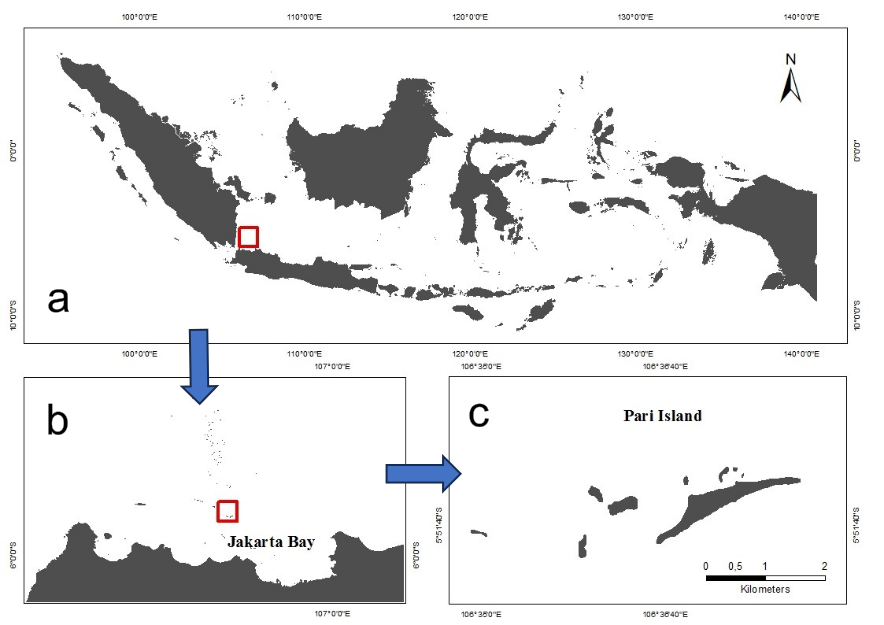
Initially, the livelihood of people in Pari Island was seaweed farming. In 2010, the seaweed yield decreased due to disease, forcing some locals to find another income source. With the encouragement of tour operators from Jakarta who saw the island’s potential as a tourist attraction, several local communities started their tourist business in Pari Island. Tourism business is not new in this area, since many islands in the surrounding Pulau Seribu were already tourist destinations. The locals learn to manage their tourism business from other islands. They provide tourists services such as travel agents/tour operators, tourist guides, lodging/homestay, catering, boat rental, snorkeling equipment, and bicycle rental. Tourism has been the primary source of livelihood for most people in Pari Island for over a decade.
3.2. Analysis using Matrix of Alliances and Conflicts: Tactics, Objectives, and Recommendations (MACTOR)
This study utilized the Matrix of Alliances and Conflicts: Tactics, Objectives, and Recommendations (MACTOR) analysis comprised of two main steps (Godet, 1991). The first step is mapping all relevant stakeholders involved in tourism management, including identifying their missions, strategies, and goals concerning tourism activity. The second step is analyzing stakeholder relationships, including describing the influence and dependence between actors and the map of the orientation of the goals of the actors, which can help in describing the potential for alliances between actors and in promoting better collective action for tourism sustainability (Fig. 2).
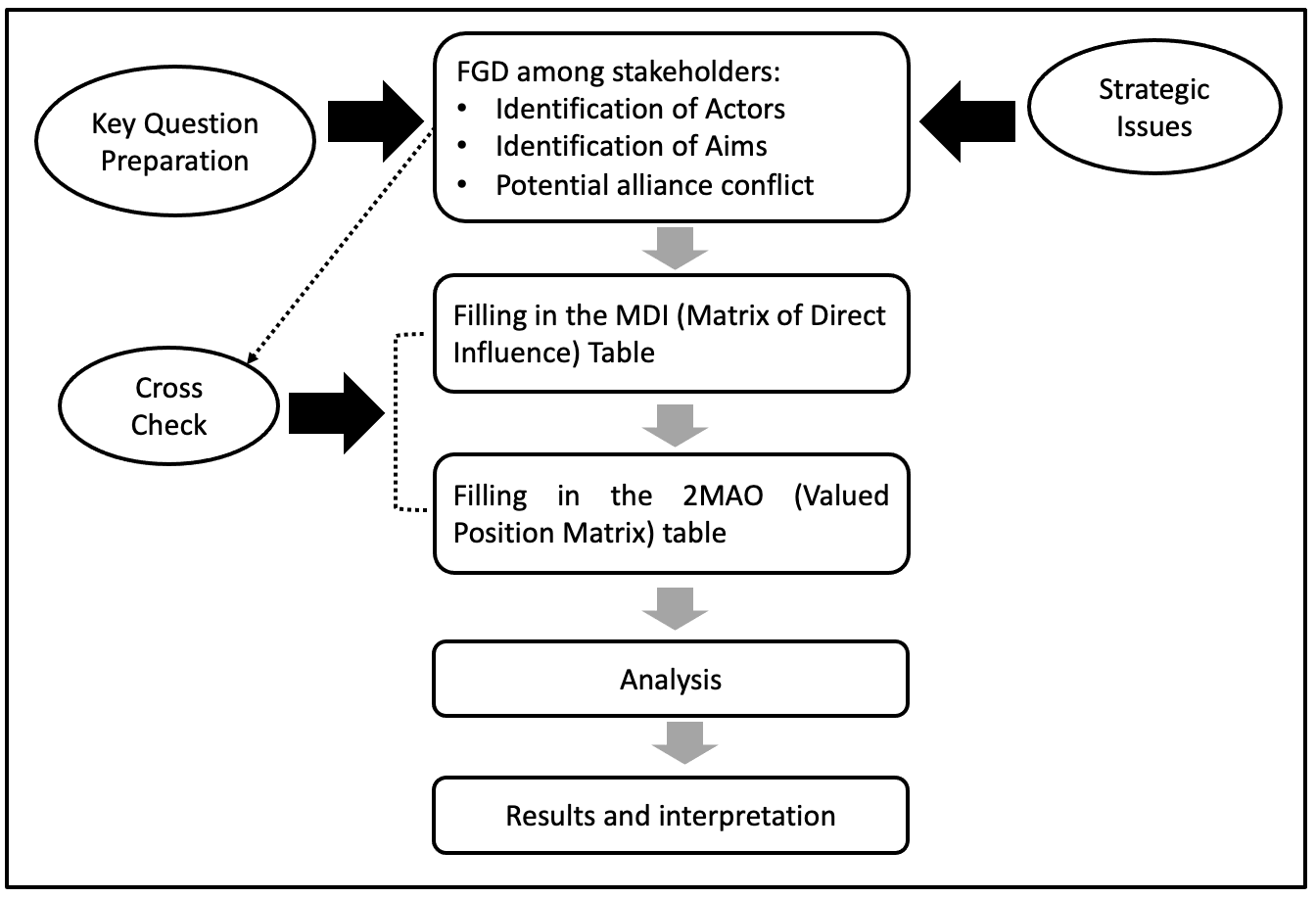
3.3. Data Collection
Data were collected in September 2022 by interviewing the actors individually via phone and through online forms. In-depth interviews were conducted to obtain data and information related to actor involvement, goal orientation, and their perspectives on tourism sustainability in Pari Island. A total of 19 respondents from tourism business actors, marine protected area activists, tourism associations, community leaders (Rukun Tetangga (RT)/Rukun Warga (RW) officials), urban village officials, and the provincial and central governments were successfully interviewed (Table 1). The same respondents were then involved in a focus group discussion (FGD) in October 2022 to obtain feedback and to discuss the interview results by bringing together all actors involved in tourism management (Manzano-Solis et al., 2019; Schmidt et al., 2020). The results of FGD were also subjected to the following analysis.
| Actor | Total person interviewed | Percentage (%) |
|---|---|---|
| External travel agent *) | 1 | 4 |
| Local travel agent | 1 | 4 |
| Ship operator from Jakarta*) | 1 | 4 |
| Tourist guide | 1 | 4 |
| Catering owner | 1 | 4 |
| Homestay owner | 1 | 4 |
| Local boat owner | 1 | 4 |
| Equipment rental owner | 1 | 4 |
| Community leaders (RT/RW officials) | 5 | 22 |
| Government outsources | 4 | 17 |
| Tourism association | 1 | 4 |
| Marine protected area activist | 1 | 4 |
| Local citizen | 2 | 9 |
| Local government *) | 1 | 4 |
| Central government *) | 1 | 4 |
| Total | 23 | 100 |
The stakeholders were asked to rate the influence of other actors on their communities by filling in the matrix of direct influence (MDI) (Godet, 1991; 2006; Godet et al., 2007). The influence of actor (i) on actor (j) was measured on a scale of 0–4 with the following conditions:
0 = no effect of actor (i) on actor (j).
1 = the influence of actor (i) on actor (j) is minimal (affecting operational procedures).
2 = the influence of actor (i) on actor (j) is moderate (affecting work).
3 = the influence of actor (i) on actor (j) is strong (influences the actor’s mission).
4 = the influence of actor (i) on actor (j) is powerful (affects the existence of actors).
Furthermore, stakeholders assessed their attitude toward the strategic goals of tourism in Pari Island by filling in the valued position matrix (2MAO). Six strategic tourism objectives in Pari Island were listed. These objectives were explained and described in sufficient detail to the participants to allow assessments. The procedure to fill in 2MAO referred to Godet (1991; 2006) and Godet et al. (2007), using a scale of 0–4 with the following conditions:
0 = the goal has a small outcome.
1 = the purpose interferes with the actor/vital procedure for the actor’s operational procedures.
2 = the goal interferes with the success of the actor’s work/vital for the success of the job.
3 = the goal interferes with achieving the actor’s mission/cannot be ignored for the actor’s mission.
4 = the purpose interferes with the existence of the actor/cannot be ignored for the existence of the actor.
The 2MAO matrix produces positive (+) and negative (−) scores. The statement after the “/” sign indicates a positive statement from the previous statement. A positive and increasing value indicates that the actor agrees with the goals.
3.4. Data Analysis
3.4.1. Identification of Actors and Goals
The results of the FGD identified 15 actors who play a direct or indirect role in marine tourism in Pari Island (Table 2).
| Category | Actor Code | Actor | Role |
|---|---|---|---|
| Primary Actors | A1 | External travel agent | Becomes a liaison for tourists and domiciled outside the island. |
| A2 | Ship operator from Jakarta | Provides boats to transport tourists from Jakarta/Tangerang to Pari Island. | |
| A3 | Local travel agent | Operators of tourism activities domiciled on the island. | |
| A4 | Tourist guide | Guide and accompany tourists during their tour of Pari Island. | |
| A5 | Catering owner | Provides the food needs of tourists while traveling on Pari Island. | |
| A6 | Homestay owner | Provides accommodation for tourists to stay on Pari Island. | |
| A7 | Local boat owner | Provides ships/boats for the needs of tourists while traveling on Pari Island (e.g., for snorkeling). | |
| A8 | Equipment rental owner | Provides tourists with snorkeling equipment, bicycles, etc. | |
| Secondary Actors | A9 | Community leaders (RT/RW officials) | Helps the subdistrict government and is a partner in empowering the community. |
| A10 | Government outsources | Represents various service units that carry out tasks related to cleanliness, maintaining public infrastructure, order, and security of the island. | |
| A11 | Tourism association | Gathers businesses in the tourism sector as a forum for facilitating tourism businesses and a place for sharing and disseminating tourism-related information. | |
| A12 | Marine protected area activist | Undertakes maintenance, repair, and supervision of marine protected areas. | |
| A13 | Local citizen | Participates in supporting the successful implementation of development in Pari Island. | |
| A14 | Local government | Designs and implements regional development and development programs. | |
| A15 | Central government | Designs and implements national priority development programs. |
Table 2 shows the complexity of the actors involved in marine tourism in Pari Island, who come from various strata (both within and outside the island). Primary actors are directly related to the operationalization of tourism in Pari Island, consisting of external travel agents, local travel agents, Jakarta ship operators, tour guides, catering owners, homestay owners, local boat owners, and equipment rental owners. Secondary actors support the implementation of marine tourism in Pari Island, such as RT/RW officials, government outsources, tourism associations, marine protected area activists, local citizens, the local government, and the central government.
3.4.2. Matrix Direct Influence (MDI)
The results of the MDI (Fig. 3) showed actor's influence level on other actors. Stakeholders in the first column were assessed based on their level of influence on the actors in the first row. Then, the level of influence of actors on each other is measured with values of 0 (no influence), 1 (affecting operational procedures), 2 (affecting work), 3 (affecting the actor’s mission), and 4 (affecting the actor’s existence).
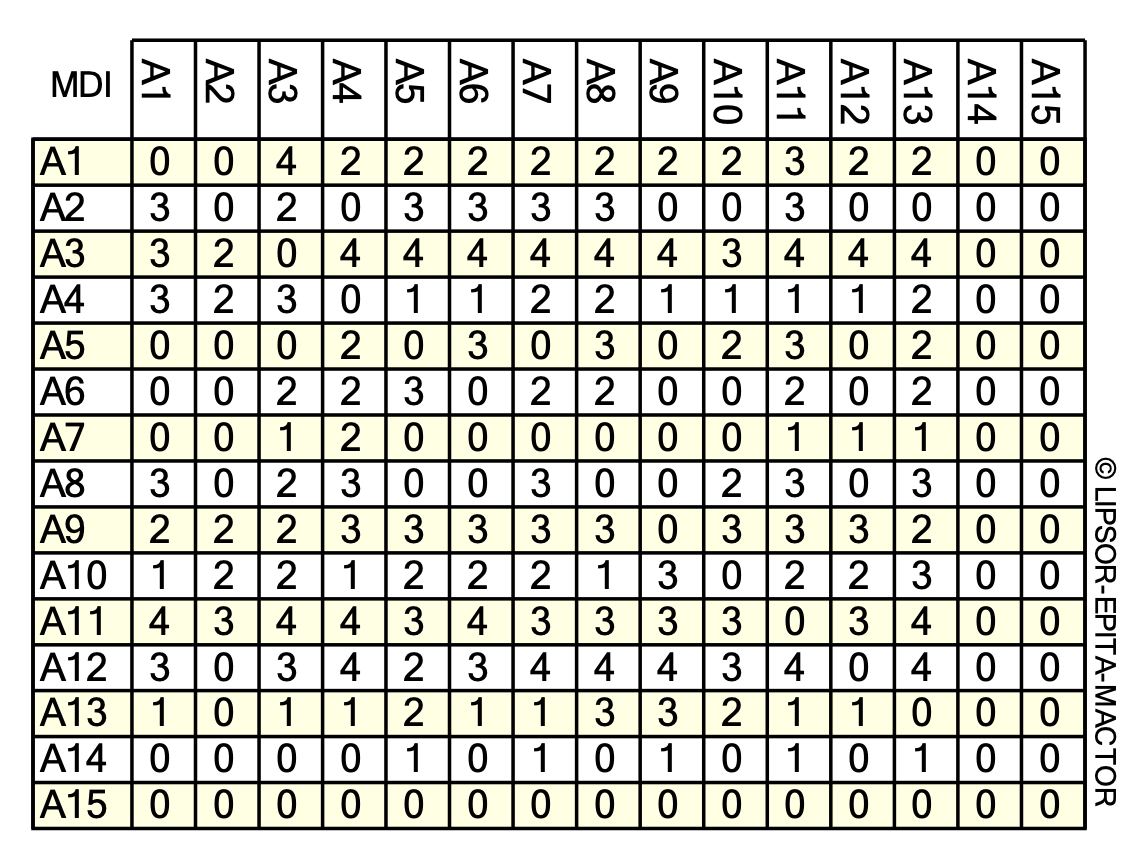
3.4.3. Valued Position Matrix (2MAO)
The FGD succeeded in identifying six strategic goals related to sustainable tourism in Pari Island. The strategic objectives include objectives O1 and O2, related to the ecological dimension; objectives O3 and O4, related to the economic dimension; and objectives O5 and O6, related to the social dimension (Table 3).
| Goal Code | Strategic Goals | |
|---|---|---|
| O1 | Goal 1 | Conservation/sustainability of natural resources and the environment |
| O2 | Goal 2 | Environmental carrying capacity |
| O3 | Goal 3 | Increased income |
| O4 | Goal 4 | Increase in the number of tourists |
| O5 | Goal 5 | Improvement of community welfare |
| O6 | Goal 6 | Even distribution of community welfare |
The valued position matrix (2MAO) constructed from FGD results (Fig. 4) explains the actor’s position toward the goals in marine tourism development on Pari Island. The actor’s position toward the goal is reflected by the actor’s attitude and assessment, i.e., supporting or rejecting the goal. A positive score indicates that the goal is vital for the actor’s mission; conversely, if the score is negative, the goal disrupts the actor’s existence (Fig. 4).
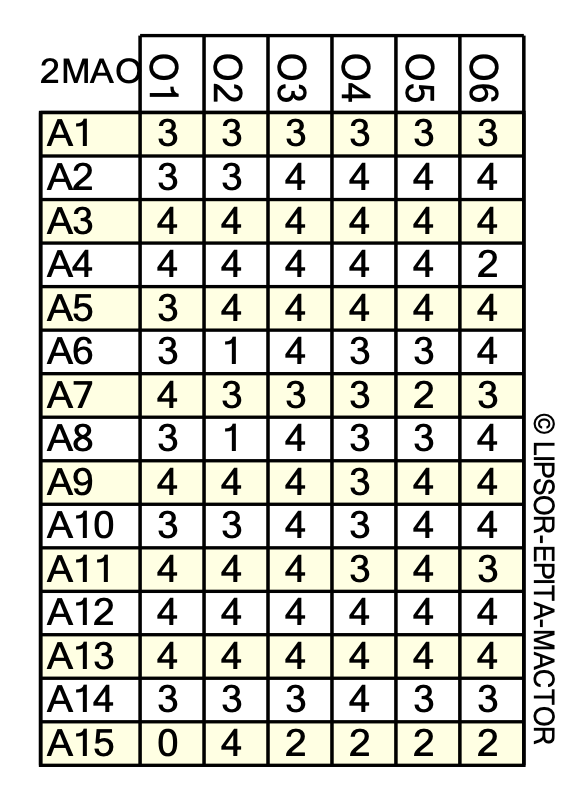
Data from MDI and 2MAO were then processed using MACTOR software version 5.3.0, producing graphics and aggregate coefficients (Godet et al., 2007). In this study, the focus was on the relationship between stakeholders and the potential for alliances/cooperation or conflicts between actors that affect tourism sustainability.
4. Results and Discussion
4.1. Influence and Dependence Between Actors
The results of the first MACTOR analysis produced a map of actor’s influence and dependencies. Actor’s influence describes their ability to influence other actors in tourism development's design, planning, and implementation stages. This influencing capability is affected by several factors, e.g., the ownership of material resources, social position, capability to take action, and knowledge of the actors regarding the future of a system (Tronvoll, 2017; Roelich and Giesekam, 2019). Actor’s positions/levels are mapped based on the level of influence and dependency into the following four types: (a) dominant actors, which are actors with strong influence and low dependency; (b) intermediaries/relay actors, which are actors who have strong influence and high dependency; (c) the dominated actor, which is the most dependent actor with low influence; and (d) the autonomous actor, which is the actor with low influence and low dependency (Godet, 1991; Elmsalmi and Hachicha, 2014; Fauzi, 2019; Fetoui, 2021).
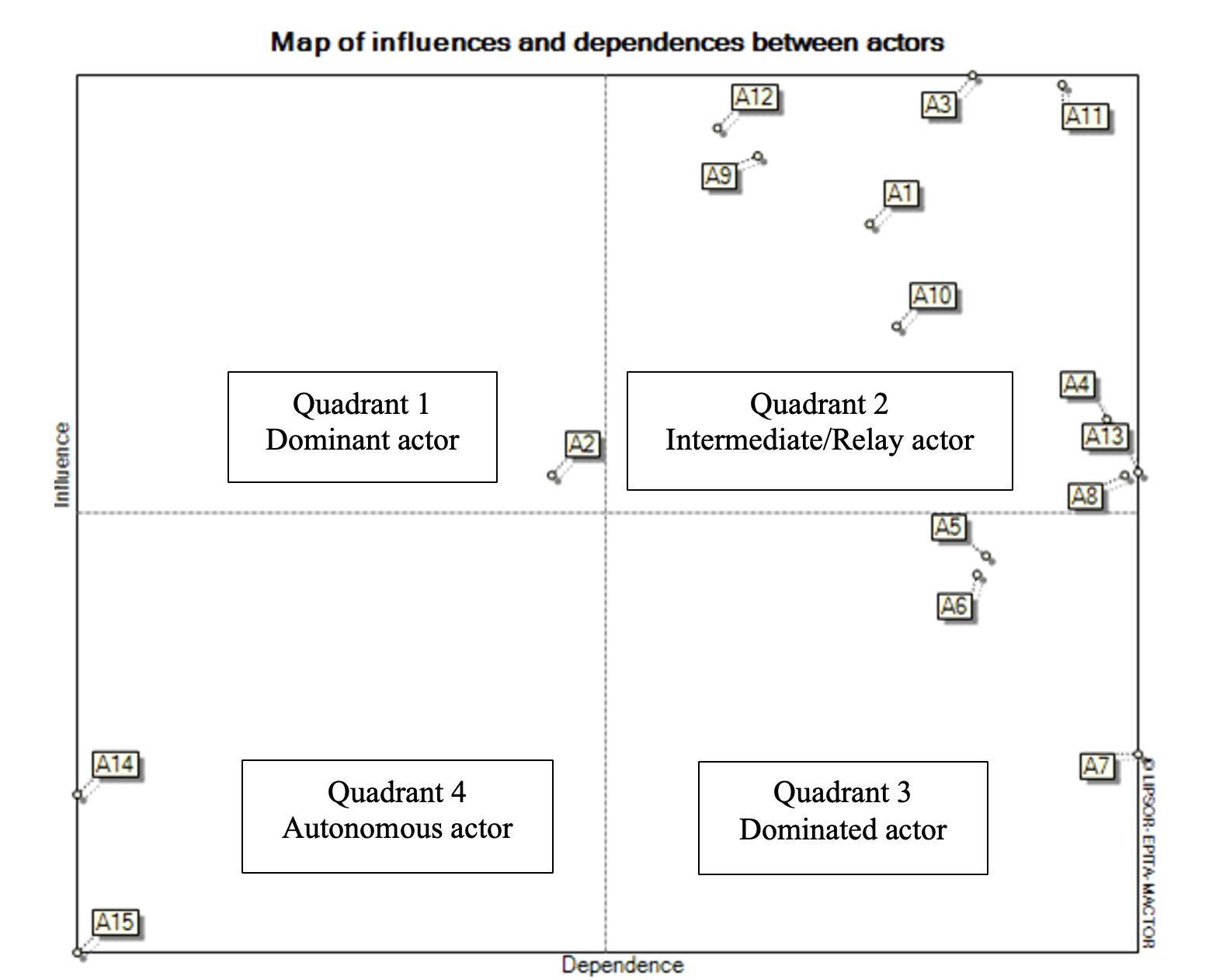
Based on the actor’s position (Fig. 5), the stability pattern of actor interaction is not ideal/stable and favors more one actor (Fauzi 2019; Riadh, 2021). In a stable system, the differences in the grouping positions of the dominant (quadrant 1) and dominated (quadrant 3) actors have more precise boundaries. Meanwhile, in Figure 5, the position of relatively many actor groupings is in quadrant 2. Intermediate/relay actors (quadrant 2) have great influence and high dependence. Because of these characteristics, these actors are unstable and more sensitive to other actors. It means that if one of the actors in this quadrant takes an action, the other actor will respond to that action.
The actors in quadrant 2 can be utilized to support marine tourism activities in Pari Island if there is good synergy between actors. These actors are expected to execute various decisions related to marine tourism on Pari Island. This type of actors will lead and determine the operational success of marine tourism development in Pari Island according to their respective capacities and roles. However, the influence and dependence of each actor tend to be high, which can threaten the sustainability of marine tourism in Pari Island with conflicts of interest between actors. This can be seen, for example, from the orientation of marine protected area activists who tend to favor the natural resources/environment conservation of Pari Island. Therefore, they prefer to limit the number of tourists. However, this goal conflicts with the orientation of business actors who are highly dependent on the tourism sector and are more concerned with pursuing income by maximizing the number of tourist visits. If there is no agreement, a conflict of interest threatens the sustainability of tourism on Pari Island. The convergence and divergence graph visualization enables the assessment of actors tendency to cooperate or be in conflict (Riadh, 2021).
Catering owners, homestay owners, and local boat owners are the dominant actors in quadrant 3, which are the actors who are highly influenced and highly dependent on other actors. In the operationalization of tourism, all three of them provide services for tourists, so they are very dependent on the occupancy level of tourists. Their working mechanism is heavily influenced by travel agents within the island (as tour operators). Local travel agents appoint the three actors to provide tourists with food, lodging, and boats. Thus, the three actors are very dependent on travel agents.
The ship operator from Jakarta (A2) is the most influential actor with a low dependency, as indicated by its position in quadrant 1 (Fig. 5). In interviews, ship operators from Jakarta mentioned that they provide many recommendations to potential tourists intending to visit the Seribu Islands, for instance, suitable islands to visit, island tour operators, and decent lodging options. Therefore, Jakarta ship operators can be considered influential actors in determining Pari Island tourist arrivals. Following its position in quadrant 1, actor A2 has a low dependency, which is reasonable because tourists were not their only income source from their ships. Tourist visits mainly during weekends or holidays. Meanwhile, on weekdays, the Jakarta ship operators serve the mobilization of the local population. Therefore, they depend not only on tourism but also on the mobilization of residents.
The local government and central government are autonomous actors (quadrant 4). In reality, the two actors tend to be passive and independent due to their indirect involvement in managing marine tourism on Pari Island. Instead, they act as a catalyst. The focus of national tourism on top-priority destinations has given the authority to manage tourism-related programs in the Seribu Islands to the local government. Conversely, the unresolved land tenure conflict in Pari Island hampered the island’s development programs and diverted to other nearby islands. This is reflected in the Seribu Islands Administrative District Strategic Plan changes for 2017–2022.
Further, MACTOR analysis revealed actor’s competitiveness map describing the intensity of the actor’s power of influence over other actors as determined by direct influence, direct dependence, indirect influence, and indirect dependence. The competitiveness map can indicate the actors’ willingness to use their power to control other actors (Elmsalmi and Hachicha, 2014; Dewani et al., 2023). The five actors with the highest consecutive competitiveness are marine protected area activists, RT/RW officials, local travel agents, tourism associations, and external travel agents (Fig. 6). This mapping is precise because the five actors, according to their roles, are related in planning and implementing community-based marine tourism in Pari Island. With this great competitiveness, they have enormous potential in determining tourism development plans in Pari Island. Meanwhile, the actor with the lowest competitiveness is the central government, and other actors are in a moderate position.

MACTOR analysis also features the matrix of maxima direct and indirect influences (MMDII), which determines the maximum level of direct or indirect influence on each pair of actors (Ben-Daoud et al., 2023). MMDII provides two types of results, i.e., (1) the maximum level of direct and indirect influence of each actor by adding a row (IMAXi) and (2) the maximum level of direct and indirect influence of each actor by adding a column (DMAXi).
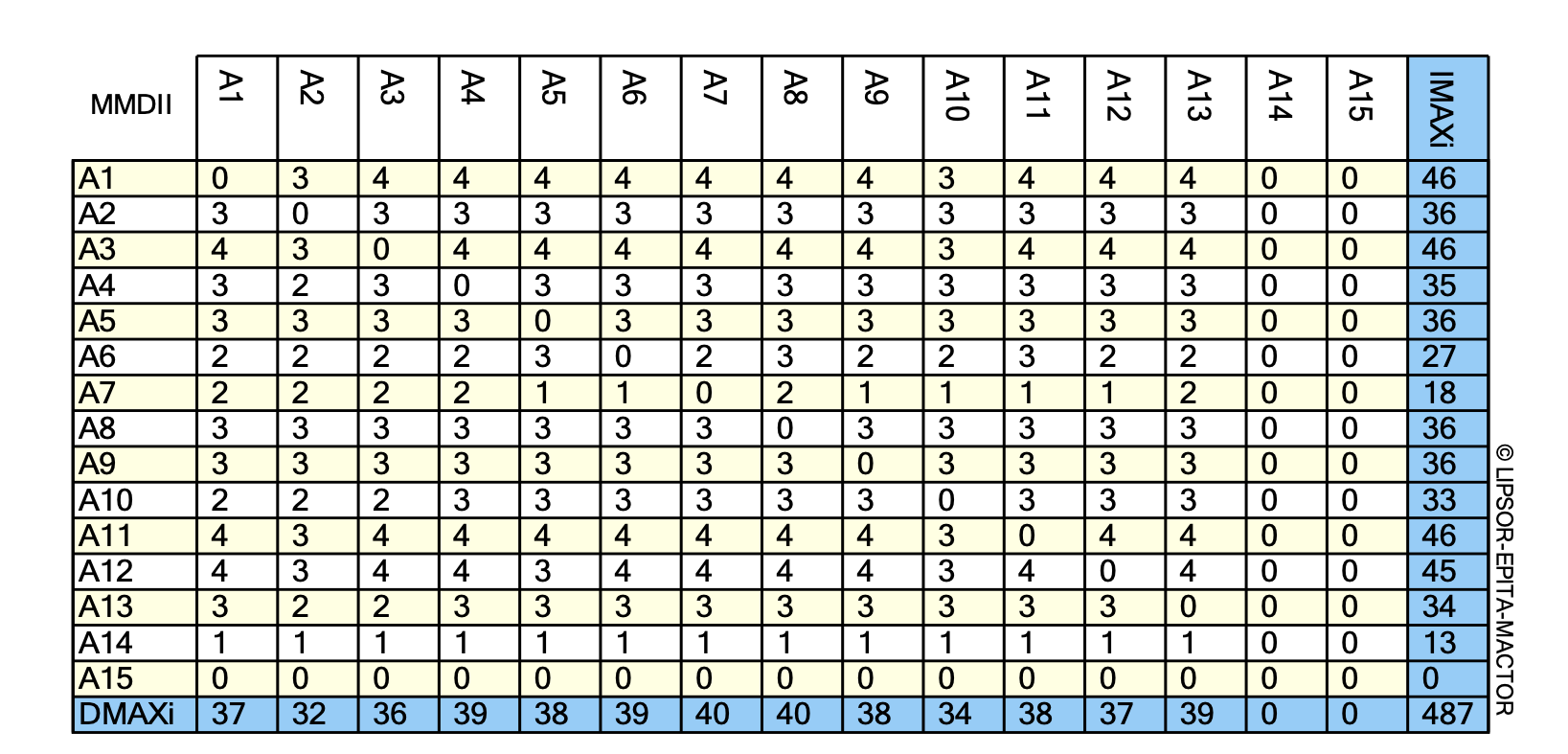
Based on the MMDII calculation (Fig. 7), the actors with the most direct and maximum indirect influence on other actors in marine tourism in Pari Island are A1 (External travel agents), A3 (Local travel agents), and A11 (tourism associations), with IMAXi value of 46. Indeed, this high value is expected because these three actors organize/implement tourism in Pari Island. The actors most influenced by other actors are A7 (owners of ships within the island) and A8 (owners of equipment rental), which is indicated by the highest maximum dependency index (DMAXi) value of 40. Actors A4 (guide/local guide), A6 (homestay owner), and A13 (local community) are the next actors most influenced by other actors, indicated by the same DMAXi value of 39. This condition is possible because, in the tourism operation, the four actors (A7, A8, A4, and A6) depend on the island’ travel agent to appoint them to serve the tourists’ needs. Meanwhile, locals (A13) depend on the tourism sector for their livelihood because seaweed cultivation activities are no longer promising.
4.2. Actor Preference for Goals
Sets of goals to be achieved within the framework of sustainable tourism in Pari Island are mapped based on their level of importance to determine the map of actor’s support for these goals. The degree of goal importance positively correlates to actor’s support. All actors support all sustainable tourism goals in Pari Island, as shown by the absence of blue color on the destination graph bar (Fig. 8). The highest intensity of support aimed to increase the income (O3), followed by welfare (O5) and equity for the community (O6), and then increase the number of tourists (O4). Based on this information, all actors are generally oriented toward economic and social goals, and ecological goals receive the lowest support from actors.
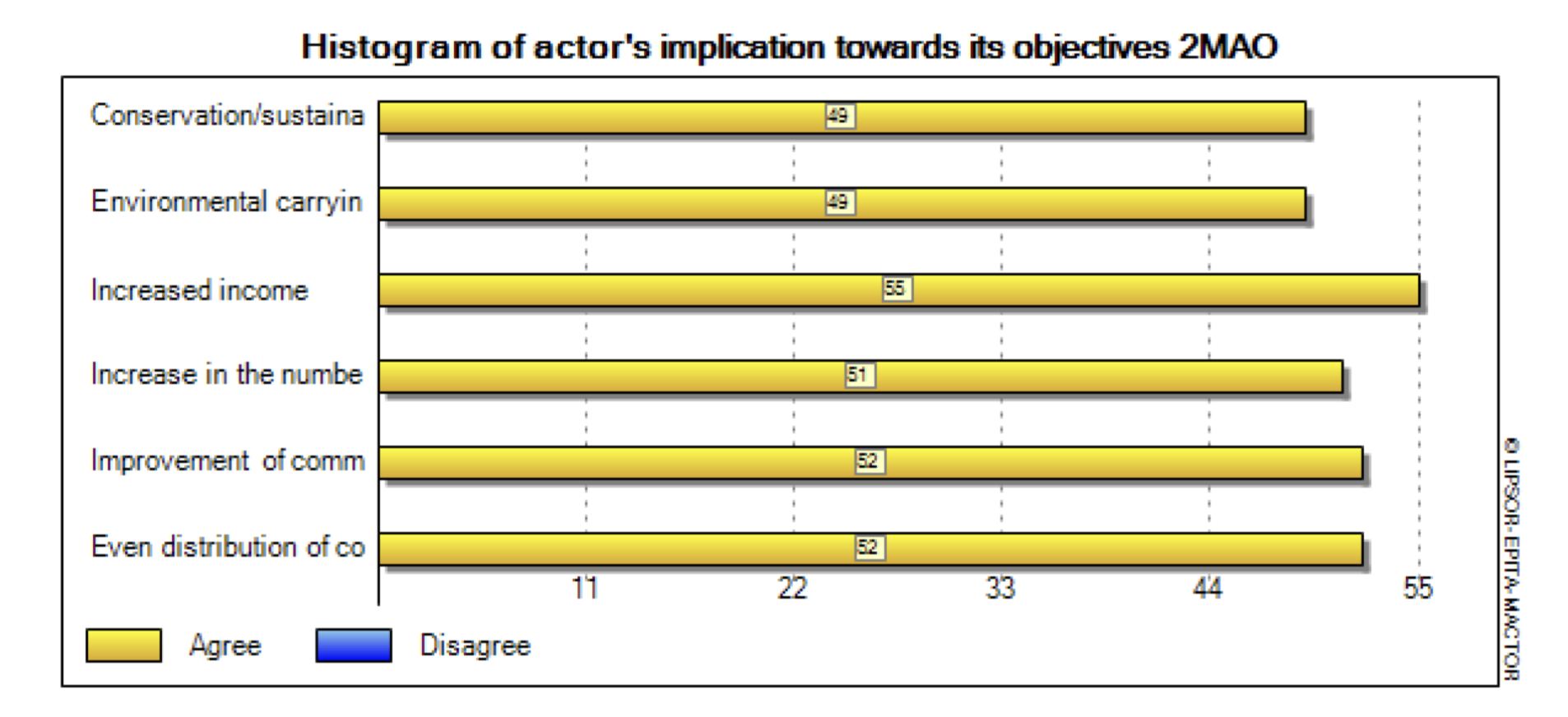
The goal orientation of each actor can be explained further with the 3MAO matrix (Fig. 9). The 3MAO matrix shows the position of each actor toward their goal in developing sustainable tourism in Pari Island. A positive value indicates the actor’s active pursuit of the goal. On the other hand, a negative value indicates the actor’s rejection toward pursuing the goal (Suprapto et al., 2022). Results showed that increased income (O3) and social welfare (O5) resulted in the highest mobility values of 57.7 and 56.4, respectively (Fig. 9). Increasing income and increasing people’s welfare are the goals that activate the actors most; in other words, these two goals are the main orientations of the actors.
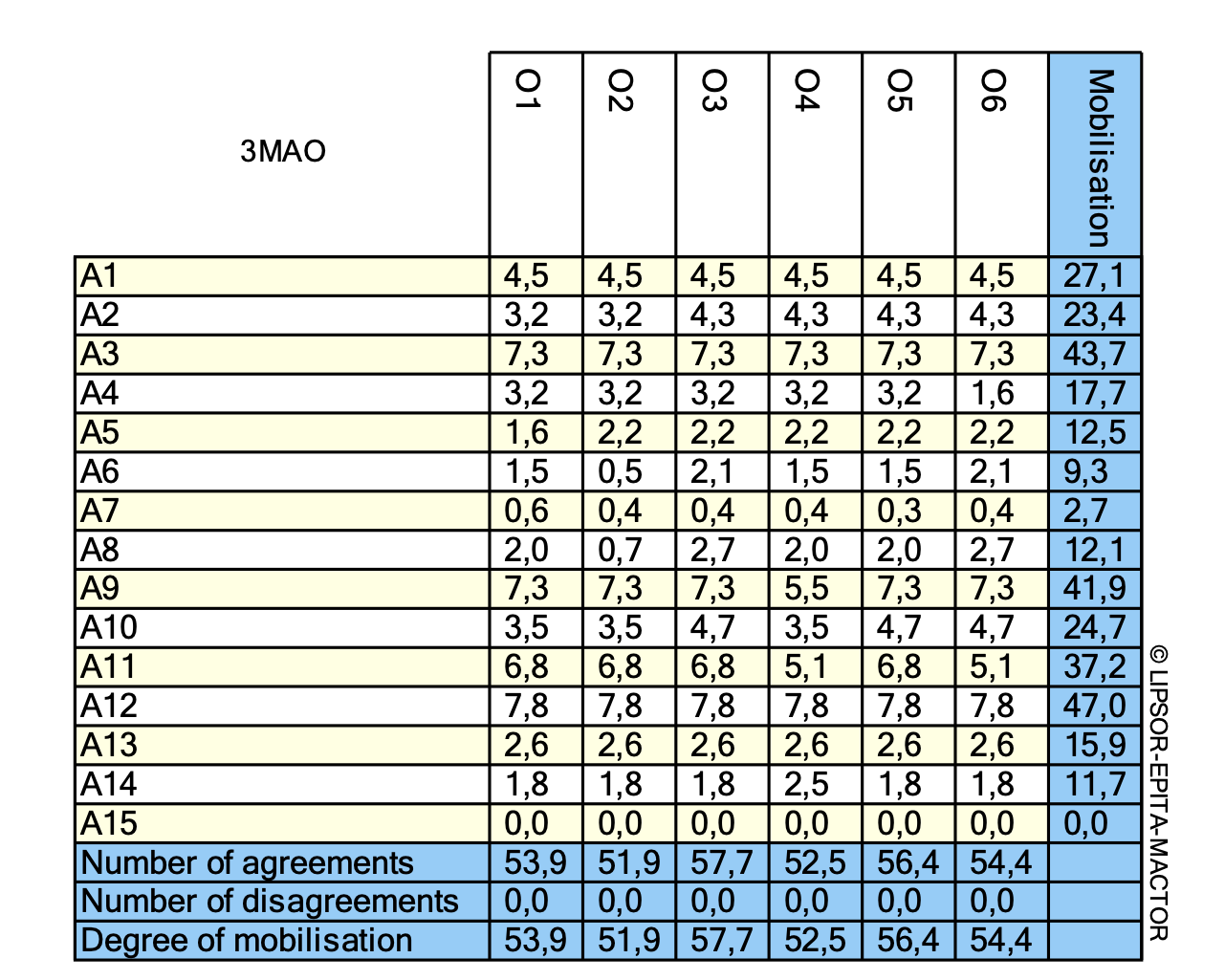
The actors with the highest degree of mobility are marine protected area activists (A12), with a score of 47.0, and local travel agents (A3), with a score of 43.7 (Fig. 9). It means that both of them are the most actively mobilized actors with stated goals in the context of sustainable tourism in Pari Island. Indeed, the role of both actors explains the results. Marine protected area activists care about conserving and preserving natural resources/environment. At the same time, travel agents within the island are tour operators and resource users who would benefit from sustainable tourism, supporting their livelihood.
Furthermore, based on the absolute sum value in the 2MAO matrix (Fig. 10), A3, A12, and A13 have the highest score of 24. Therefore, marine protected area activists, local travel agents, and local citizens are the actors with the highest importance toward the stated goals. Based on this information, in the context of tourism development, they are central actors expected to realize sustainable tourism in Pari Island.
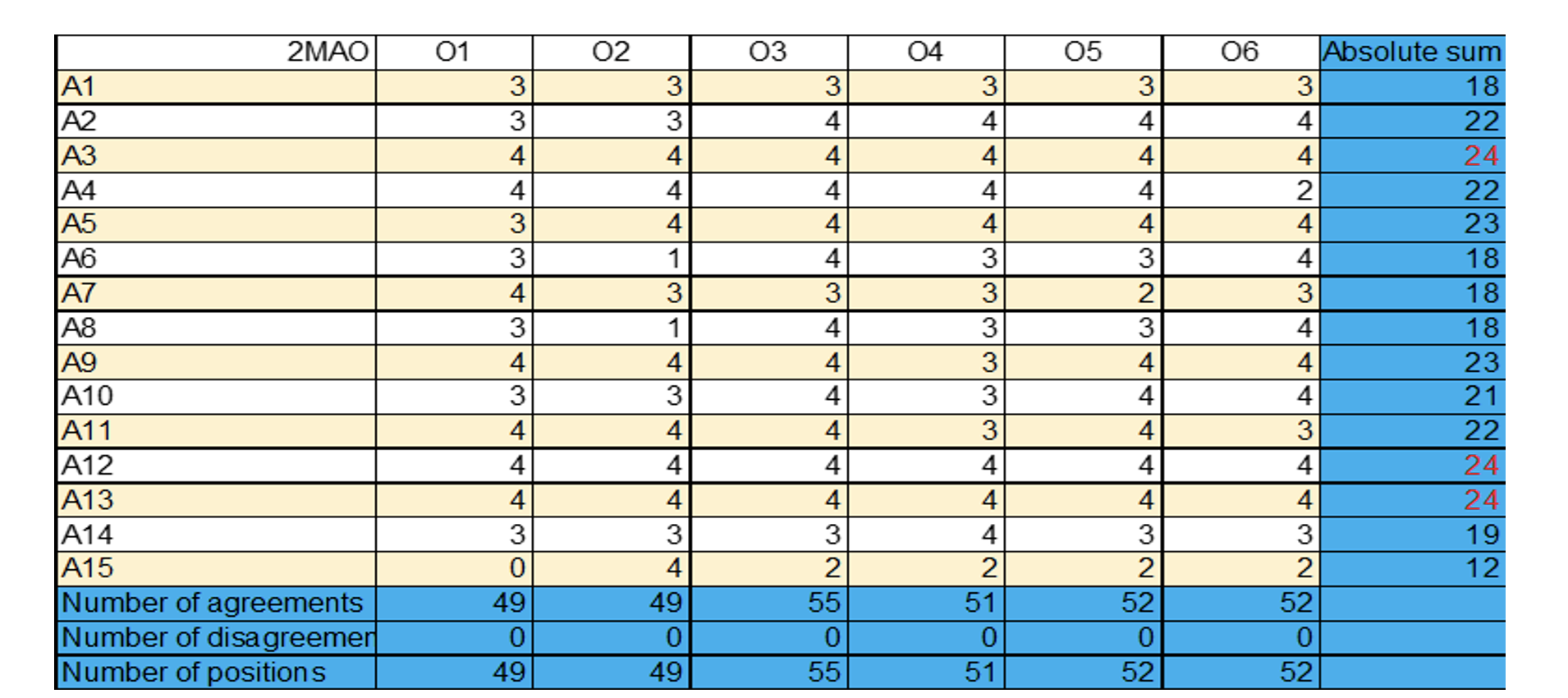
4.3. Potential for Collaboration (Convergence) and Conflict (Divergence) Between Actors
Actor convergence describes the similarity of actors’ attitudes toward goals. Actors with the same attitude will converge, whereas those with different attitudes will diverge. Convergence analysis is intended to identify possible points of potential alliance between actors. Convergence maps can be used to determine which actors can work together to avoid potential conflicts. Figure 11 displays the convergence analysis results (3CAA) between actors (valued convergence). This matrix identifies some similar positions actors have toward achieving sustainable tourism goals in Pari Island.
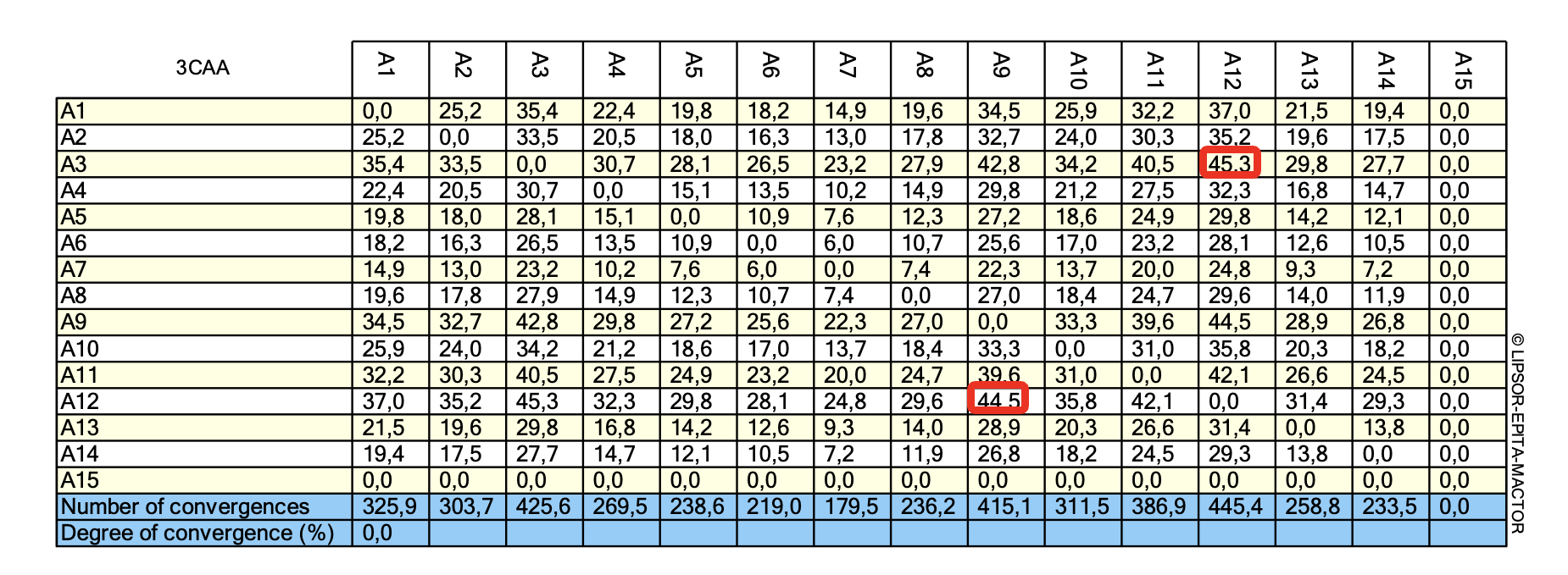
The local travel agents (A3) and marine protected area activists (A12) are actors who have the highest correlation of interest relationship, as indicated by a convergence coefficient of 45.3 in 2022 (Fig. 11). Likewise, between marine protected area activists (A12) and community leaders (RT/RW officials) (A9) with a convergence coefficient of 44.5. Furthermore, the level of convergence between these actors is very high, as shown by the strongest connection lines (Fig. 12). This strong relation shows that they have a common goal of achieving the success of sustainable tourism in Pari Island. Therefore, when these three actors are committed to building an alliance (cooperation), it is highly likely that sustainable tourism can be achieved.
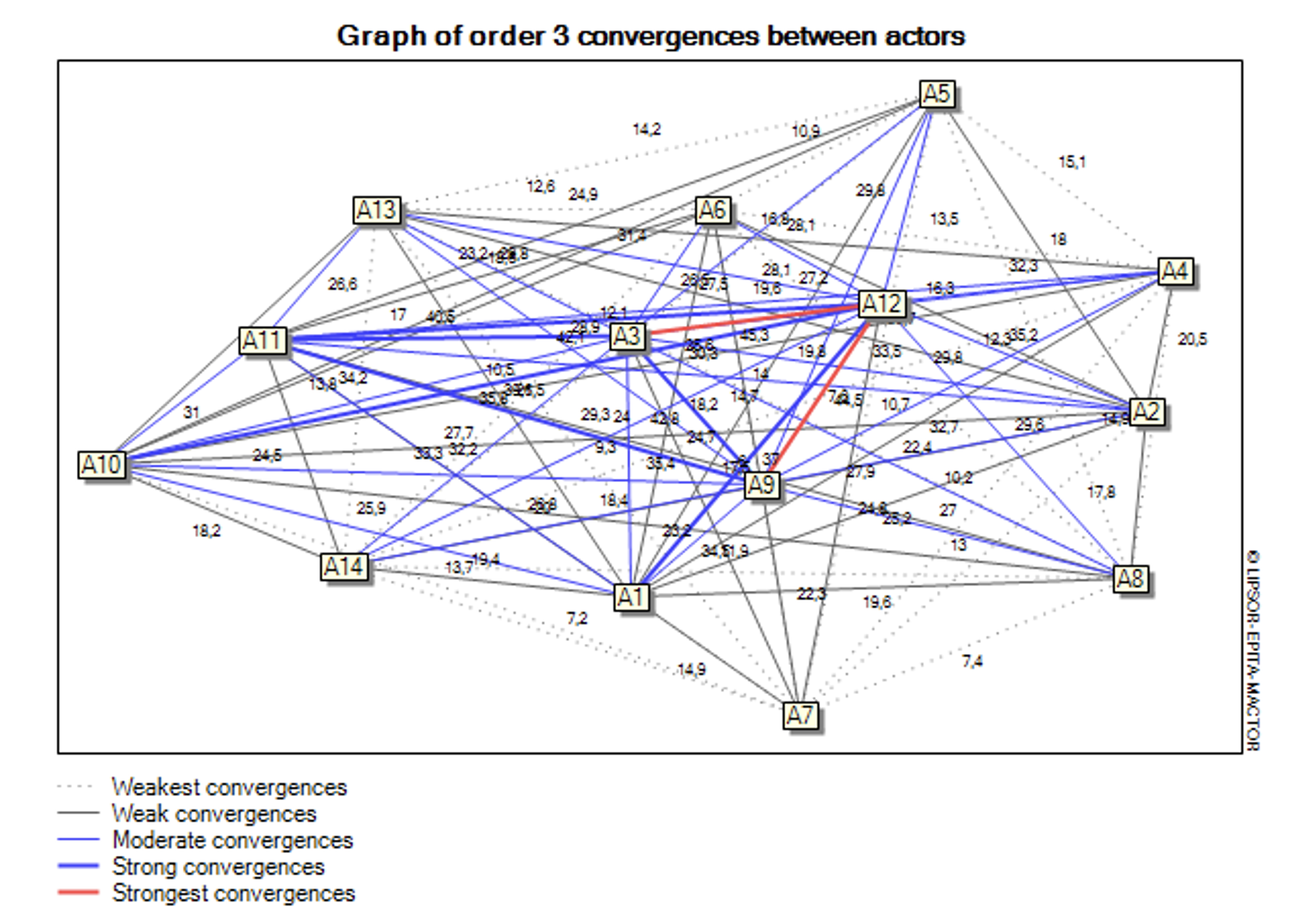
The deviation values between actors were all zero, indicating no differences (divergence) in interest in achieving goals between actors. Therefore, the possibility of conflict between actors is minor to nonexistent. From the management perspective, this condition is a strategic social capital for realizing sustainable Pari Island tourism.
The ambivalent value of all actors was also zero, meaning there were no ambivalent actors. In other words, all marine tourism actors in Pari Island show an attitude that is in line with the goals set in the context of sustainable tourism and is not against them even though the goals are not in line with them. Under these conditions, all actors have the potential to be invited to collaborate in realizing sustainable tourism in Pari Island.
5. Conclusion and Recommendations
The actors involved in managing community-based marine tourism in Pari Island came from inside and outside the island with specific roles. The analysis of the influence and interdependence between actors has placed actors in a strategic context where actors are expected to respect each other’s competitive advantages. This research has found that most actors are convergent with no potential for actor divergence and no ambivalent actors.
In developing sustainable tourism in Pari Island, several strategic objectives identified were strongly supported by all actors. The marine protected area activists, local travel agents, and local communities are actors with the highest interest in the goals set. Based on the level of convergence, marine protected area activists and local travel agents have the strongest connection lines with the same goal of achieving the success of sustainable tourism in Pari Island.
The value of actor divergence shows that community-based tourism management in Pari Island has been carried out without causing conflicts of interest between the actors involved. All marine tourism stakeholders in Pari Island show an attitude that aligns with the goals set and is not against them, even though the goals are not in line with them. Under these conditions, all stakeholder actors have the potential to collaborate, especially in balancing economic, social, and ecological objectives, to realize sustainable tourism in Pari Island.
Based on the findings above and to optimize marine tourism management oriented toward sustainable tourism, this research proposes a collaborative governance model (Jung et al., 2019). In the collaborative governance model, the actors involved are jointly responsible for realizing sustainable tourism in Pari Island. In a broader sense, each actor, with his or her capacity, actively contributes to balancing sustainable tourism goals between economic, social, and ecological aspects and is not solely oriented toward one own’s goal. In managing marine tourism in Pari Island, the problems that may arise, such as resource exploitation, land space density, and water contamination, are not the sole responsibility of marine protected area activists, community leaders, or local communities. These problems, instead, must be resolved by the cross-sectoral involvement of all existing actors. Lahat and Sher-Hadar (2020) stated that the dimensions of collaborative governance include the following: (i) patterns of interaction between collaborating partners, (ii) coalition structures formed by collaborative partners, and (iii) patterns of information sharing between collaborative partners.
Developing sustainable tourism in Pari Island should start with the goals that all actors support before reaching the other goals. Based on the level of influence and dependency of the actors, the competitiveness of the actors, their level of importance to the goals set, and their convergence opportunities, four actors (marine protected area activists, local travel agents, community leaders, and local communities) are identified as the central actors who play the most crucial role in balancing various goals to pursue the realization of sustainable tourism in Pari Island. However, supporting other actors according to their respective capacities is essential to establish future participatory governance toward sustainable tourism. This perspective can be used to condition and accommodate actors in different power spaces/quadrants.
The context of marine tourism problems on Pari Island shows that anyone can use marine resources without any restrictions whatsoever. Therefore, with the increasing number of tourists, this resource utilization can cause difficulties for other tourists to use these resources, and the benefits will decrease because of excessive exploitation. Tourism development in Pari Island should not only be seen as an effort to take advantage of economic potential alone, but it can also be an instrument in empowering the community’s economy and solving fundamental environmental problems due to tourism. In the short term, actors must respond to current conditions in the form of exploitation of coral reef resources, population density, land space, and the potential impact of healthy water and water contamination, including the incomplete status of land ownership.
Based on the ideological strength of each actor, collaborative governance can take on the role of an “institutional middle ground” in managing the tourism potential of Pari Island and carrying out its development in the future. Based on the management of tourism, which has been running at the initiative of the community and taking into account land conflicts between the community and the private sector, the management of community-based marine tourism in Pari Island can be continued. Through this model, the community can manage resources jointly and sustainably by building local institutions according to the needs and conditions of Pari Island. Thus, this can solve the “tragedy of the commons” dilemma by properly managing common-pool resources.
The proposed institutional “middle way” is not the only solution to the dilemma of tourism resource utilization in Pari Island. The main thought is that there are various ways to overcome the dilemmas in using Pari Island's tourism resources. Therefore, it is essential to find the most suitable solutions to overcome the misuse of resources. To achieve the longevity and sustainability of the management of a resource, what needs to be considered is not the form of regime owned by the government, the private sector, or individuals but how compatible the management or ownership governance is with the ecological system of the area concerned, including the characteristics of the people.
Several steps need to be determined to ensure that resources remain sustainable, i.e., (1) making agreements or engagement between all resource users (the alternative is to make sure that all potential users are aware of the space and the rules that may apply); (2) careful monitoring of resources; and (3) penalties should be applied to punish the users who do not comply with the established agreements regarding the proper use of resources. Finally, the findings of this research are expected to be used as a basis for building a collaborative governance model in developing the tourism potential of Pari Island. Successful governance should bring more benefits and provide opportunities to all actors involved, including becoming a model for tourism development in other small islands in Indonesia.
Acknowledgments
The study was fully funded by The COREMAP-CTI Project 2021–2022 (17/A/DK/2021) with the project title of “Ketahanan Sumber Daya Air dan Lingkungan Pulau Pari Menuju Resilient Small Island.” The authors thanked Dr. Dyah Marganingrum, the stated project's coordinator, for allowing participation in research and project activities.
References
- Ahmad, F., Draz, M. U., Su, L., Rauf, A., 2019. Taking the bad with the good: The nexus between tourism and environmental degradation in the lower middle-income Southeast Asian economies. J. Clean. Prod. 233: 1240–1249. https://doi.org/10.1016/j.jclepro.2019.06.138.
- Avelino, F., Wittmayer, J. M., 2016. Shifting power relations in sustainability transitions: A multi-actor perspective. J. Environ. Policy Plan. 18(5): 628–649. https://doi.org/10.1080/1523908X.2015.1112259.
- Baldacchino, G., 2015. Archipelago Tourism: Policies and Practices. Ashgate, Surrey, UK.
- Baldacchino, G., 2018. The Routledge International Handbook of Island Studies: A World of Islands, 1st ed. Taylor and Francis, London, UK.
- Bangwayo-Skeete, P.F. and Skeete, R.W., 2020. Modelling tourism resilience in small island states: A tale of two countries. Tour. Geogr. 23(3): 436-457. https://doi.org/10.1080/14616688.2020.1750684.
- Ben-Daoud, M., El Mahrad, B., Moroșanu, G.A., Elhassnaoui, I., Moumen, A., El Mezouary, L., ELbouhaddioui, M., Essahlaoui, A. and Eljaafari, S., 2023. Stakeholders’ interactions in Water Management System: Insights from a MACTOR analysis in the R’Dom Sub-basin, Morocco. Environ. Manage. 71: 1129–1144. https://doi.org/10.1007/s00267-022-01773-x
- Bódi, B., Takács-Sánta, A., 2021. Hardin’s mistake: Tikopia, the society that avoided the tragedy of the commons. World Futures, 77(3): 205-221. https://doi.org/10.1080/02604027.2020.1788356.
- Brunnhuber, S., 2022. The Real Tragedy of the Commons–Garrett Hardin (1968) Revised. Problemy Ekorozwoju. 17(2). https://doi.org/10.35784/pe.2022.2.02.
- Cadoret, A. 2021. Conflicts and acceptability of visitation management measures for a marine protected area: The case of Porquerolles, Port-Cros National Park. Ocean Coast. Manage. 204: 105547. https://doi.org/10.1016/j.ocecoaman.2021.105547.
- Cannonier, C., Burke, M.G., 2019. The economic growth impact of tourism in Small Island Developing States—Evidence from the Caribbean. Tour. Econ. 25(1): 85–108. https://doi.org/10.1177/135481661879279.
- Chi, Y., Liu, D., 2023. Measuring the island tourism development sustainability at dual spatial scales using a four-dimensional model: A case study of Shengsi archipelago, China. J. Clean. Prod. 388: 135755. https://doi.org/10.1016/j.jclepro.2022.135775.
- Crozier M., Friedberg E., 1980. Actors and Systems: The Politics of Collective Action. University of Chicago Press, Chicago.
- Damayanti, M., Tyas, W.P., Aswad, W.O.S.J., 2021, February. Conceptualizing multi actors’ collaboration in smart tourism destination. In IOP Conference Series: Earth and Environmental Science. 673(1): 012027). IOP Publishing. https://doi.org/ 10.1088/1755-1315/673/1/012027.
- Dewani, I.D.A.M.N., Saskara, I.A.N., Setyari, N.P.W., 2023. The role of stakeholders in the sustainability of the Simantri program in Tabanan. Jurnal Penelitian Pendidikan Indonesia. 9(2): 659-668. https://doi.org/10.29210/020232204
- Dimitrovski, D., Lemmetyinen, A., Nieminen, L. and Pohjola, T., 2021. Understanding coastal and marine tourism sustainability-A multi-stakeholder analysis. J. Dest. Mark. Manage. 19: 100554. https://doi.org/10.1016/j.jdmm.2021.100554.
- Elmsalmi, M., Hachicha, W., 2014. Risk mitigation strategies according to the supply actors’ objectives through MACTOR method. In: 2014 International Conference on Advanced Logistics and Transport (ICALT). Hammamet, Tunisia, pp. 362–367.
- Endi, F. and Prasetyo, D., 2020. Factors influencing french tourists to visit Bali. Tour. Res. J. 4(1): 25-44. https://doi.org/10.30647/trj.v4i1.73.
- Fetoui, M., Frija, A., Dhehibi, B., Sghaier, M., Sghaier, M., 2021. Prospects for stakeholder cooperation in effective implementation of enhanced rangeland restoration techniques in southern Tunisia. Rangel. Ecol. Manage. 74: 9–20. https://doi.org/10.1016/j.rama.2020.10.006.
- Figueroa B, Eugenio., Rotarou, Elena S., 2021. Island tourism-based sustainable development at a crossroads: facing the challenges of the COVID-19 pandemic. Sustainability. 13(18): 10081. https://doi.org/10.3390/su131810081.
- Godet, M., 1991. Actors’ moves and strategies: The mactor method. An air transport case study. Futures. 23(6): 605–622. https://doi.org/10.1016/0016-3287(91)90082-D.
- Godet, M., 1994. From Anticipation to Action: A Handbook of Strategic Prospective. Future-Oriented Studies. UNESCO Pub, France.
- Godet, M., 2006. Creating Futures: Scenario Planning as a Strategic Management Tool. Economica, Paris.
- Godet, M., 2007. Manuel de prospective stratégique. Paris: Dunod. http://www.laprospective.fr/dyn/francais/ouvrages/la_prospective_strategique/t2--manuel-de-prospective-strategique-dunod-2007.pdf (accessed 20 April 2023).
- Graci, S., Van Vliet, L., 2020. Examining stakeholder perceptions towards sustainable tourism in an island destination. The Case of Savusavu, Fiji. Tour. Plan. Dev, 17(1): 62-81. https://doi.org/10.1080/21568316.2019.1657933
- Graci, S., Maher, P. T., 2018. Tourism, in: The Routledge International Hanbook of Island Studies: A World of Island, 1st ed. Taylor & Francis, London, UK.
- Grilli, G., Tyllianakis, E., Luisetti, T., Ferrini, S., Turner, R. K., 2021. Prospective tourist preferences for sustainable tourism development in Small Island Developing States. Tour. Manage. 82. https://doi.org/10.1016/j.tourman.2020.104178.
- Gu, Y., Onggo, B. S., Kunc, M. H., Bayer, S., 2021. Small Island Developing States (SIDS) COVID-19 post-pandemic tourism recovery: A system dynamics approach. Curr. Issues Tour. 1-28. https://doi.org/ 10.1080/13683500.2021.1924636.
- Han, H., 2021. Consumer behavior and environmental sustainability in tourism and hospitality: A review of theories, concepts, and latest research. J. Sustain. Tour. 29(7): 1021-1042. https://doi.org/10.1080/09669582.2021.1903019
- Hardin, G., 1968. The tragedy of the commons. Science vol 162, pp 1243–1248.
- Harrison, D., 2015. Development theory and tourism in developing countries: What has theory ever done for us? In: IJAPS, Vol. 11.
- Heger, T., Rohrbeck, R., 2012. Strategic foresight for collaborative exploration of new business fields. Technol. Forecast. Soc. Change. 79(5): 819–831. https://doi.org/10.1016/j.techfore.2011.11.003.
- Hemaphan, P., 2017. Determinant of stakeholder participation towards sustainable tourism development: An empirical study of active beach destinations in Thailand. Sripatum Rev. Humanit. Soc. Sci. 17(1): 103–114.
- Heslinga, J., Groote, P., Vanclay, F., 2021. Strengthening governance processes to improve benefit-sharing from tourism in protected areas by using stakeholder analysis. In Living on the Edge (pp. 69-83). Routledge.
- Isa, M., Fauzi, A., Susilowati, I., 2019. Flood risk reduction in the northern coast of Central Java Province, Indonesia: An application of stakeholder’s analysis. Jàmbá: J. Disaster Risk Stud. 11(1): 1-9. https://doi.org/10.4102/jamba.v11i1.660.
- Juerges, N., Leahy, J., Newig, J., 2020. A typology of actors and their strategies in multi-scale governance of wind turbine conflict within forests. Land Use Policy. 96: 104691. https://doi.org/10.1016/j.landusepol.2020.104691.
- Jung, Y., Mazmanian, D., Tang, S., 2019. Collaborative governance in the United States and Korea: Cases in negotiated policymaking and service delivery. Int. Rev. Public Admin. 13(sup1): 1–11. https://doi.org/10.1080/12294659.2009.10805136.
- Kisi, N., 2019. A strategic approach to sustainable tourism development using the A’WOT hybrid method: A case study of Zonguldak, Turkey. Sustainability. 11(4). https://doi.org/10.3390/su11040964.
- Lahat, L., Sher-Hadar, N., 2020. A threefold perspective: Conditions for collaborative governance. J. Manage. Gov. 24(1): 117–134. https://doi.org/10.1007/s10997-019-09465-1.
- Lesmana, H., Sugiarto, S., 2021. Formulating a competitive advantage model for tourism destinations in Indonesia. J. Asian Finance Econ. Bus. 8(3): 237-249. https://doi.org/10.13106/jafeb.2021.vol8.no3.0237
- Mafruhah, I., Supriyono, S., Mulyani, N. S., Istiqomah, N., 2020. Causality between tourism industry development and the ecological sustainability in marine environment: A convergence and divergence among stakeholder with mactor analysis. Int. J. Energy Econ. Policy. 10(4): 85–92. https://doi.org/10.32479/ijeep.7989.
- Mahardika, S. M. A. H., Yulianda, F., Adrianto, L., Sulistiono., 2022. Prospective analysis of the role of actors in governing mangrove ecosystem area in Tangerang District, Indonesia. Biodiversitas J. Biol. Diver. 23(9): 4940–4947. https://doi.org/10.13057/biodiv/d230964.
- Manzano-Solís L. R., Díaz-Delgado, C., Gómez-Albores, M. A., Mastachi- Loza, C. A., Soares, D., 2019. Use of structural systems analysis for the integrated water resources management in the Nenetzingo river watershed, Mexico. Land Use Policy. 87: 104029. https://doi.org/10.1016/j.landusepol.2019.104029.
- Manzoor, F., Wei, L., Asif, M., Haq, M.Z.U., Rehman, H.U., 2019. The contribution of sustainable tourism to economic growth and employment in Pakistan. Int. J. Environ. Res. Public Health, 16(19): 3785. https://doi.org/10.3390/ijerph16193785
- Meza-Arce, M. I., Malpica-Cruz, L., Hoyos-Padilla, M. E., Mojica, F. J., Arredondo-García, M. C., Leyva, C., Zertuche-Chanes, R., Santana-Morales, O., 2020. Unraveling the white shark observation tourism at Guadalupe Island, Mexico: Actors, needs and sustainability. Mar. Policy, 119: 104056. https://doi.org/10.1016/j.marpol.2020.104056.
- Nguyen, T.Q.T., Johnson, P., Young, T., 2022. Networking, coopetition and sustainability of tourism destinations. J. Hosp. Tour. Manag. 50: 400-411. https://doi.org/10.1016/j.jhtm.2022.01.003
- Niekerk, M.V., Getz, D. 2019. Chapter 1 Introduction to Stakeholder Theory. In: Niekerk, M.V., Getz, D. (eds), Event Stakeholders. Oxford: Goodfellow Publishers. http://dx.doi.org/10.23912/9781911396635-4090
- Nurhasanah, I. S., Hudalah, D., Van den Broeck, P., 2023. Systematic Literature Review on Alternative Governance Arrangements for Resource Deficient Situations: Small Island Community-Based Ecotourism. Isl. Stud. J. early access. https://doi.org/10.24043/001c.85173
- OECD., 2022. Tourism Trends and Policies 2022. OECD Publishing, Paris. https://doi.org/10.1787/a8dd3019-en.
- Ostorm, E., 1990. Governing the Commons: The Evolution of Institutions for Collective Action. Cambridge University Press, Cambridge.
- Peterson, R.R., 2020. Over the Caribbean top: Community well-being and over-tourism in small island tourism economies. Int. J. Commun. Well-Being. 1–38. https://doi.org/10.1007/s42413-020-00094-3.
- Presenza, A., Cipollina, M., 2010. Analysing tourism stakeholders networks. Tourism Review. 65(4): 17–30. https://doi.org/10.1108/16605371011093845.
- Rahardjo, M., Gravitiani, E., Sasanti, I. A., 2023. Toward Sustainable Tourism: Insights for Mactor Analysis In Ngebel Lake, Indonesia. Econ. Dev. Anal. J. 12(3): 396-407. https://doi.org/10.15294/edaj.v12i3.70969
- Rees, G. H., MacDonell, S., 2017. Data gathering for actor analyses: A research note on the collection and aggregation of individual respondent data for MACTOR. Future Stud. Res. J: Trends Str. 9(1): 115–137. https://doi.org/10.24023/FutureJournal/2175-5825/2017.v9i1.256.
- Riadh, H. 2021. Intelligent tourism system using prospective techniques and the Mactor methodology: a case study of Tunisian tourism. Curr. Issues Tour. 25(9): 1376-1398. https://doi.org/10.1080/13683500.2021.1937072
- Rodríguez Díaz, M., Espino Rodríguez, T., 2016. Determining the sustainability factors and performance of a tourism destination from the stakeholders’ perspective. Sustainability. 8(9). https://doi.org/10.3390/su8090951.
- Roelich, K., Giesekam, J., 2019. Decision making under uncertainty in climate change mitigation: introducing multiple actor motivations, agency and influence. Clim. Policy, 19(2): 175-188. https://doi.org/10.1080/14693062.2018.1479238
- Roxas, F.M.Y., Rivera, J.P.R., Gutierrez, E.L.M., 2020. Mapping stakeholders’ roles in governing sustainable tourism destinations. J. Hosp. Tour. Manage. 45: 387-398. https://doi.org/10.1016/j.jhtm.2020.09.005.
- Santosa, A.A.G.D.H., Utami, P.D.Y., Wijaya, I.M.M., 2021. Reforming the tourism promotion board for an effective tourism promotion in Indonesia: A legal perspective. IKAT: The Indonesian J. Southeast Asian Stud. 5(1): 61-71. https://doi.org/10.22146/ikat.v5i1.64562
- Schmidt, L., Falk, T., Siegmund-Schultze, M., Spangenberg J.H., 2020. The objectives of stakeholder involvement in transdisciplinary research: A conceptual framework for a reflective and reflexive practise. Ecol Econ. 176: 106751. https://doi.org/10.1016/j.ecolecon.2020.106751.
- Sianipar, C.P., Chao, Y.M., Hoshino, S., 2023. Multi-Actor Systems in Water–Energy Nexus: Identifying Critical Stakeholders in Floatovoltaic (Floating Photovoltaic) Project. Water, 15(6): 1241. https://doi.org/10.3390/w15061241.
- Suprapto, F.A., Juanda, B., Rustiadi, E., Munibah, K., 2022. Analysis of Economic Vulnerability to Disaster Threats in Batu City. JEJAK J. Econ. Vulnerability. 15(2): 368-388. https://doi.org/10.15294/jejak.v15i2.36728
- Suryahani, I., Susilowati, I., Maria, N. S., Mafruhah, I., 2020. Management Of Natur And Cultural Al Tourism In Dieng, Indonesia: Empirical Study With Mactor Analysis. Intl. J. Manage. 11(7). https://doi.org/10.34218/IJM.11.7.2020.109
- Triyono, 2013. Penilaian Ekonomi dan Daya Dukung Wisata Bahari di Pulau Pari Kepulauan Seribu Provinsi DKI Jakarta. Institut Pertanian Bogor, Bogor.
- Tronvoll, B., 2017. The actor: The key determinator in service ecosystems. Systems. 5(2): 38. https://doi.org/10.3390/systems5020038.
- Turker, N., Alaeddinoglu, F., Can, A. S., 2016. The role of stakeholders in sustainable tourism development in Safranbolu, Turkey. Conference: International Conference on Hospitality, Leisure, Sports, and Tourism.
- Venables, A., Tan, G., Pradhan, S., 2014. A collaborative framework for a cross-institutional assessment to shape future IT professionals. Issues Informing Sci. Inf. Technol. 11: 215–223. https://doi.org/10.28945/1990.
- Wallace, K., Michopoulou, E., 2019. The stakeholder sandwich: A new stakeholder analysis model for events and festivals. Event Manage. 23(4-5): 541-558. https://doi.org/10.3727/152599519X15506259855742.
- Wondirad, A., Tolkach, D., King, B., 2020. Stakeholder collaboration as a major factor for sustainable ecotourism development in developing countries. Tour. Manage. 78: 104024. https://doi.org/10.1016/j.tourman.2019.104024
- World Tourism Organization (WTO), 2021. COVID-19 related travel restrictions–A global review for tourism, 11th report, 26th November 2021. Madrid: UNWTO.
- World Tourism Organization (WTO), 2022. UNWTO World Tourism Barometer and Statistical Annex, May 2022. Vol. 20(3), May. https://doi.org/10.18111/wtobarometereng.
- Wouthuyzen, S., Abrar, M., 2020. Gugusan Pulau Pari, Kepulauan Seribu: Tinjauan Aspek Bio-Ekologi, Sosial-Ekonomi-Budaya, dan Pengelolaan Berkelanjutan. Jakarta: LIPI Press.
